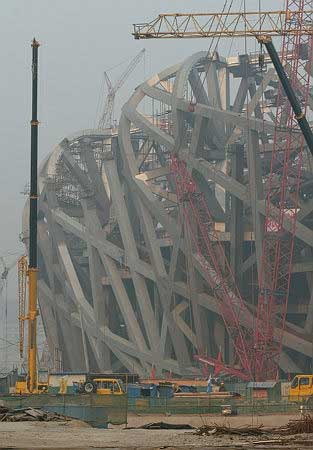 The Beijing Olympic Stadium Birds Nest.
The Beijing Olympic Stadium Birds Nest.
WILL THIS STADIUM BE A BIRDS NEST FOR SPECTATORS
OR WILL IT END UP AS A SPIDER'S WEB?
Written
by Ed Craig.
Posted www.weldreality.com.
Aug. 2. 2008.
The
five hundred million dollar, Beijing Olympic Stadium, is wrapped
with a unique high strength steel box cocoon that weighs approx.
45,000 metric tons of steel plate. The plates were welded into hollow sections
with a cross section of up to 1.2 m and then transported to the site for assembly.
The longest section is 300 meters. Unwrapped, the strands of the bird's nest would
stretch for 36 km.
At the end of July, two weeks before the 91000 seat
stadium was ready to host the 2008 Olympics, In my home in North Carolina, I sat
before my TV and watched a Discovery Channel program about the Bird's Nest stadium
construction. The Bird's Nest steel design was without question a wonder
to behold, however having a slight interest in welding, (www.weldreality.com)
you know where my focus was.
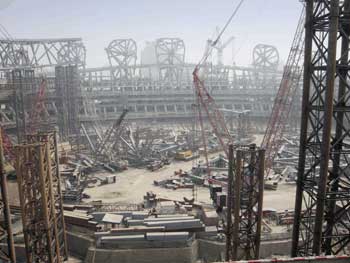 As I watched the show, my first concern
was that it appeared that many of the site construction welds were
made with stick or self shielded flux cored electrodes. From my perspective these
weld processes would not have been the first choice to attain consistent, acceptable
weld quality, especially for long length, multi-pass welds on high strength steels.
Keep in mind that these welds also will be subject to unusual loads and stresses,
on a structure that sits on top of an earth quake fault. As I watched the show, my first concern
was that it appeared that many of the site construction welds were
made with stick or self shielded flux cored electrodes. From my perspective these
weld processes would not have been the first choice to attain consistent, acceptable
weld quality, especially for long length, multi-pass welds on high strength steels.
Keep in mind that these welds also will be subject to unusual loads and stresses,
on a structure that sits on top of an earth quake fault.
Ship yards, oil
platforms and pipe lines, know that when it comes to laying consistent weld quality
that will meet the complete mechanical weld properties, especially ductility /
strength / impact properties, you go with the "gas shielded flux cored wires"
and highly trained weld personnel.
Experienced
weld personnel can look at a weld as it's being made in the job shop or in watch
the same weld sitting in front of a TV. The weld spatter length, the spatter cascade
pattern and spatter amount indicates if a weld is in or out of control. On my
TV, I saw many welds that were out of control. The poor weldability on the high
strength steels and the lack of obvious weld automation on the joint connections,
left me wondering what the impact would be from the miles of welds that had to
have numerous weld defects such as lack of weld fusion, excess porosity, excess
slag entrapment and excess weld heat.
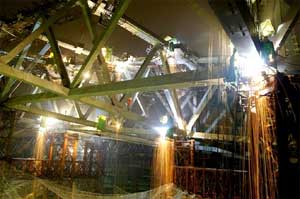 [] I have provided weld best practices and weld process control
work shops in over 1000 companies in twelve countries, and it only took a few
minutes in front of my TV, to know that the $8- $10 a day Chinese weld personnel
I saw, were inexperienced and were using questionable weld techniques, poor weld
consumables and inappropriate weld parameters. [] I have provided weld best practices and weld process control
work shops in over 1000 companies in twelve countries, and it only took a few
minutes in front of my TV, to know that the $8- $10 a day Chinese weld personnel
I saw, were inexperienced and were using questionable weld techniques, poor weld
consumables and inappropriate weld parameters.
[]
I wondered at how much real world weld quality controls was applied for internal
weld evaluation on a project which had a six months delay due to design issues
with the roof which thank god was never installed.
[] I wondered when NDT
was applied, what weld quality acceptance criteria was used and how many weld
joints of the total weld joints were subject to UT examinations that would reveal
internal weld defects.
[] I wondered at the weld quality of the welded
structures and beams that were welded before they were delivered to the stadium.
After all, you would think there would be a continuity with the welding practices
utilized on a project. Yet the stadium weld practices I saw, would not provide
any confidence in the off site weld quality
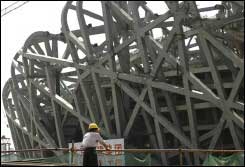 []
I wondered with the complex joint angles, the illogical loads and the logical
distortion issues, how it was possible to maintain acceptable weld gap dimensions
or how it was possible to eliminate the extraordinary weld stresses. []
I wondered with the complex joint angles, the illogical loads and the logical
distortion issues, how it was possible to maintain acceptable weld gap dimensions
or how it was possible to eliminate the extraordinary weld stresses.
I
wondered during the summer peak and winter low temperatures how the weld joint
joints would handle the expansion and contraction stresses, especially on weld
joints with unknown weld defects and stresses
[] I wondered what was done
to bridge the over size roots gaps and what was done to remove the root and first
/ second pass defects that are always a part of these structural type welds.
[]
I wondered what the root pass criteria was for complete weld penetration welds
and what the notch influence, stress and impact properties would be for the unintended
over sized root gaps or from the excess slag entrapment and lack of root weld
fusion.
[] I wondered with the high humidity in the day time and the night
time cold and damp, if the consumables were correctly stored and only used in
the shift in which they were removed from their sealed containers.
[]
I wondered how many welds were made on steels still cold or wet (see ice below)
or on steels without the correct edge or weld surface preparations. I then wondered
if either hydrogen cracking or lack of weld fusion and porosity which typically
results from these conditions will rear its ugly head in the critical and none
critical weld joints.
[] I wondered what the long or short term outlook
would be from the weaker heat affected zones that were generated from the excess
weld gaps with their excess welds and possible lack of interpass temperature controls.
Also what the eventual negative influence would be from the internal weld defects
in welds attached to high strength steels that had excess grain growth from excess
weld heat.
[] I wondered
how many weld start stop tie ins had lack of weld fusion or trapped weld slag
and did each welder have a grinder and instructions to properly remove the weld
slag and defects from each weld pass.
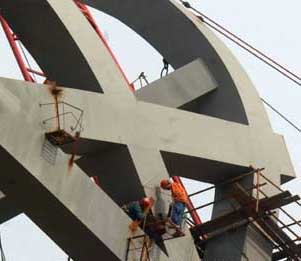 []
I wondered what the weld quality impact was from the the $8- $10 a day welders.
Especially when those weld personnel who were welding 200 feet in the air, hanging
by a rope, welding critical "all position weld joints" which of course
had to have questionable joints and edge preps. []
I wondered what the weld quality impact was from the the $8- $10 a day welders.
Especially when those weld personnel who were welding 200 feet in the air, hanging
by a rope, welding critical "all position weld joints" which of course
had to have questionable joints and edge preps.
[] I wondered how the Chinese officials define their skilled welders and
were they aware that process / consumable expertise is also necessary. It's ironic
that when the weld issues occur on this project, the welders willl likely take
the blunt of the blame, when the weld reality the responsibility completely lies
with the on site weld management.
[] I noticed also during the TV program,
that when a Chinese engineer brought up the discussion of weld issues with the
architect, the architect shrugged his shoulders, smiled and went back to receiving
accolades from those around him.
The global common Architect / designer
"weld apathy and indifference" is no different I suppose than the California
architects who ignored their selection of the pathetic poorly suited self shielded
flux cored wires for the structural steel welds that failed miserably in many
buildings during the North Ridge Earth
Quake.
As it would place less load and stresses on those twisted, highly stressed beams
and those questionable welds, the fact
that the heavy retractable sliding roof was canceled for this project had to be
a relief to the engineers and especially for the 90,000 people that would eventually
sit in this stadium.
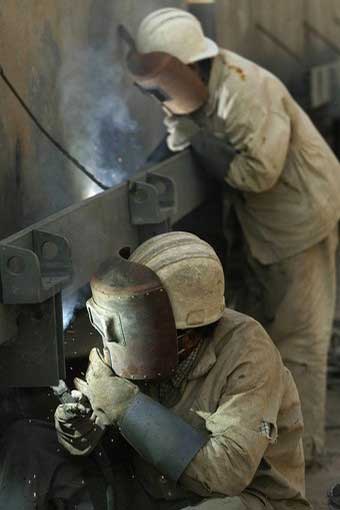 When
it comes to welding, the majority of global architects when designing complex
steel projects, will have their head in the clouds and actually believe that their
finished projects will be complete with welds that meet the weld design criteria,
a task that few global projects ever attain. When
it comes to welding, the majority of global architects when designing complex
steel projects, will have their head in the clouds and actually believe that their
finished projects will be complete with welds that meet the weld design criteria,
a task that few global projects ever attain.
Thanks to weld process control apathy,
few architects or designers get involved with the weld process decisions that
will ensure the welds on their projects meet their design criteria. Even fewer
are aware of how they can add to their design to enhance the weldabilty of construction
welds subject to numerous variables.
Take a look at the Chinese picture
on the right. Do the one handed welds (required with use of cheap face masks)
and the blocked weld helmet view glass inspire confidence that the the
welds were correctly applied. Do you believe that the consumables that were used
on this construction site, would have been correctly stored and regulated
on a day to day basis? Can you really imagine that each weld edge prep had the
correct dimensions, and the weld edges were properly prepared and cleaned? To
meet the weld impact requirements in the event of an earth quake, each weld pass
would have required extensive grinding before the next pass. I have my doubts
that this was the common practice.
 When
you want to avoid manufacturing or construction issues in an industrial nation
where hopefully quality programs and standards are well established, you adopt
those standards and apply them with logical best practices and process controls. When
you want to avoid manufacturing or construction issues in an industrial nation
where hopefully quality programs and standards are well established, you adopt
those standards and apply them with logical best practices and process controls.
China
is not a country where you expect to find rigid quality specifications applied
to it's construction projects or manufactured components. To confirm this in 2008,
simply pick up a product at Wallmart, or view the buildings that were damaged
in the last Chinese earth quake.
Architects from around the world may
look to China as the goose that lays the golden construction eggs, but what they
need to remember is China at this time has a huge swollen Achilles heel."It
has had a very different construction quality philosophy, from that which has
been is established in the West"
CHINA CLAIMS: Chief Commander
of Beijing national stadium construction Tan Xiaochun says welding these steel
structures alone was a big challenge. "The total length of the welding lines is 320-kilometers, which is about the length of a return journey from Beijing
to it's neighboring port city of Tianjin. It took 1,100 welders 15 months to complete
and the 100 percent weld pass-rate during quality
checks set a record in China's architectural history."
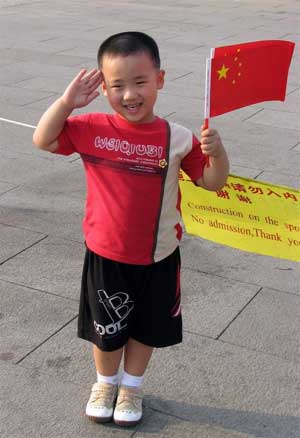 Ed
replies. That statement about a 100% weld pass rate is a "red flag" and not a surprise from a government
official that is likely used to lies, exaggerated claims or censorship to deal
with anything that may cause party officials embarrassment. For me, the claimed
100% weld pass rate was a red flag about the total project's weld quality acceptance
criteria. Ed
replies. That statement about a 100% weld pass rate is a "red flag" and not a surprise from a government
official that is likely used to lies, exaggerated claims or censorship to deal
with anything that may cause party officials embarrassment. For me, the claimed
100% weld pass rate was a red flag about the total project's weld quality acceptance
criteria.
If
the person in charge of the stadium construction, did make that ridiculous 100%
weld statement, it's a statement that should cast a large shadow over the credibility
of the on site construction engineering decisions, and especially cast doubts
about the fabrication / weld quality of the total project.
As
this USA web site proves, we in the West with all our resources and advantages
and hands off managers, still have a difficult time building a ship, an oil platform
or any large construction project with out major costly welding issues. Meanwhile
in 2008, Chinese contractors have miraculously developed a method in which a mega
project with 1000, $10 a day "manual welders" with all their human inconsistencies
and obvious lack of process control training, managed to achieve a 100% weld pass
rate. This is a reason when you enter this site, www.weldreality.com, that you
have to click on a bull, and we all know bulls don't like red
flags.
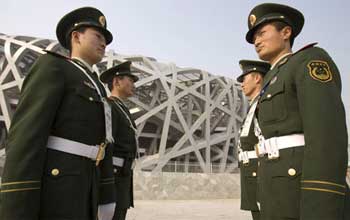 When
an architect plans a mega steel construction project that will be a cocoon for
90,000 spectators on a site that sits on an earth quake fault, that Architect
has a responsibility not only to think about the design cosmetics, the architect
has to also think about the project safety, maintenance and durability. When
an architect plans a mega steel construction project that will be a cocoon for
90,000 spectators on a site that sits on an earth quake fault, that Architect
has a responsibility not only to think about the design cosmetics, the architect
has to also think about the project safety, maintenance and durability.
I
believe the designers of the Birds Nest were ignorant about the lack of best weld
practices and weld processes and consumables utilized. I believe the designers
did not factor in the general lack of weld process control / expertise that would
be found in a third world country with a reputation for inconsistent workmanship
and poor product quality products.
Any experienced architect should give
consideration to the weld quality implications and consequences that will occur
in a third world country without
conventional construction practices, weld codes and standards. No matter how far
China believes it has come, China is a
country in which crooked contractors and ignorant political party members are
likely to have more influence on the construction site weld quality / fabrication,
than the impotent, contractual, construction specifications stuffed in a file
in the construction managers and architects office.
If
you are in the welding business, you know that codes and standards are a necessity,
however those codes and standards when applied to mega welding projects, will
provide no weld guarantees, when influenced by
manual idiosyncrasies, hands off weld management, ioddeadline concerns, poor engineering
process choices and the common lack of process controls. China paid more than
500 hundred million dollars for this project, yet this nation did not appear to
hold itself or it's contractors accountable for the quality of the product delivered.
Chinese
engineers and officials have had a great opportunity to learn from the weld engineering
mistakes of the west. If these engineers had desired, they could have applied
to the construction of the Birds Nest, a set of new age welding standards, best
weld practices and weld process controls that truly would have attained a real
world, 100% weld pass rate. However I believe that the weld reality in China is,
that qualified, honest engineers will rarely get to control multi-million dollar
projects.
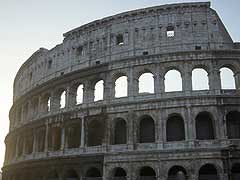 The
Birds Nest is an incredible, unique design and without question a construction
project that the Chinese workers should be proud of. However when you get down
to it, we have too many global large construction projects in which the focus
is on the visual ,cosmetic wrappings rather than on the integrity of the contents
inside the package. The
Birds Nest is an incredible, unique design and without question a construction
project that the Chinese workers should be proud of. However when you get down
to it, we have too many global large construction projects in which the focus
is on the visual ,cosmetic wrappings rather than on the integrity of the contents
inside the package.
The architects for this project did not choose
long lasting concrete type materials which were  used
to build the great stadiums of Rome. For their Beijing art piece, open to severe
weather changes and built on an earth quake fault, the designers supposedly designed
this project to last 100 years. used
to build the great stadiums of Rome. For their Beijing art piece, open to severe
weather changes and built on an earth quake fault, the designers supposedly designed
this project to last 100 years.
It's been my experience
that if a project does not have good weld practices it also will not have good
paint or coating practices.
On this steel monolith, I would anticipate
premature rust. The rust will occur on a structure who's strength will not come
from it's unique design or steel mechanical properties, the Birds Nest strength
and longevity is much more likely to be determined by it's weakest weld or weld
joint.
My
40 years of weld process control experience, my gut instinct when viewing a one
hour movie on the Discovery Channel and the ridiculous Chinese claim of weld perfection,
make me believe this nest was not built in accordance with the designer's "weld
quality requirements". The bottom line, is this construction project was
supposed to represent the future potential of China, however I believe this project,
rather than inspire Chinese engineering capability should generate many concerns,
especially when the next earth quake sends a tremor through the city of Beijing.
The
following was published by Breaking News -- Jan 21, 2008 and Updated May 08, 2008
The
Beijing Olympic Birds Nest.
Chinese
authorities have attempted to cover up the death's of up to ten Olympic stadium
workers in the lead up to the Beijing Olympics in August. The Sunday Times newspaper
reported that Chinese officials had offered the families of those killed during
the stadium's construction large compensation pay outs in exchange for silence
over their loves one's deaths. The families have reportedly been offered up to
190,000 Chinese Yuan ($30,000 Australian), in agreement they would not talk to
the media or reveal their family member's death during the Olympic stadium's construction.
One
worker at the "Bird's Nest" Olympic stadium said he recalled several
deaths, including that of a fellow welder. "On the top of the 'bird's nest'
I could see some ice. I stood on the ground, thinking
of how best to climb to the top to get on with the welding," he said."Just
at that moment I heard a terrible scream. Before I realized what had happened
I heard a thump on the ground. I suddenly realized that someone had fallen from
the top of the nest"
Note
from Ed. When you are ready to cover up death, covering up poor welds has to be
child's play. Construction deaths are normal on a project of this scope, however
I would be shocked if anyone took an oxy fuel torch up to those weldments and
removed the ice and preheated the steel before starting the welds.
UPDATE
10 MONTHS LATER. MAY 2009:
E-Mail
From Europe
Dear Ed:
Your
comments on welding quality at Birds Nest stadium in August 2008 may well be at
the heart of the current problems which I heard via the grapevine today. A team
of European engineers has been called in to address the Bird's Nest problems of
rust, corrosion and splits in the structure. And
this is a stadium that has hosted just ONE major event since the Olympics! So
it's not as if overuse is causing problems.It has been obsolescent in a year due
to poor construction and poor business planning.
 May
2009: Response from Ed. May
2009: Response from Ed.
Thank god they did not put the roof on the stadium,
who knows what that excess dynamic loads would have resulted in during the games.
The main body of the National Stadium was supposed to have a design life of 100
years and withstand an 8-magnitude earthquake. Well it did not require an earthquake
but after 6 months it appears to be having extensive structural problems. As I
believe that most of the bad weld joints will not be repairable, I see the Birds
Nest on it's way to the scrap yard in a few years. As global engineering consultants
study this project and milk more money from Chinese tax payers, they will I am
sure after an extensive study, come to the conclusion similar to that written
at this site before the games began.
As for the Chinese, they would do well to take a look towards Rome. Over a 1000
years ago, the romans knew that if you want design, low maintenace, function and
longevity, you think "concrete".
Click
here to return to ww.weldreality.com, the world's largest
web site on MIG and flux cored weld best practices and weld process controls.
| |